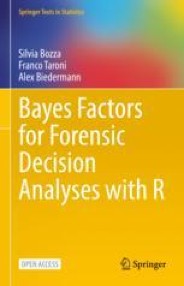 My friend EJ Wagenmaker pointed me towards an entire book on the BF by Bozza (from Ca’Foscari, Venezia), Taroni and Biederman. It is providing a sort of blueprint for using Bayes factors in forensics for both investigative and evaluative purposes. With R code and free access. I am of course unable to judge of the relevance of the approach for forensic science (I was under the impression that Bayesian arguments were usually not well-received in the courtroom) but find that overall the approach is rather one of repositioning the standard Bayesian tools within a forensic framework.
My friend EJ Wagenmaker pointed me towards an entire book on the BF by Bozza (from Ca’Foscari, Venezia), Taroni and Biederman. It is providing a sort of blueprint for using Bayes factors in forensics for both investigative and evaluative purposes. With R code and free access. I am of course unable to judge of the relevance of the approach for forensic science (I was under the impression that Bayesian arguments were usually not well-received in the courtroom) but find that overall the approach is rather one of repositioning the standard Bayesian tools within a forensic framework.
“The [evaluative] purpose is to assign a value to the result of a comparison between an item of unknown source and an item from a known source.”
And thus I found nothing shocking or striking from this standard presentation of Bayes factors, including the call to loss functions, if a bit overly expansive in its exposition. The style is also classical, with a choice of grey background vignettes for R coding parts that we also picked in our R books! If anything, I would have expected more realistic discussions and illustrations of prior specification across the hypotheses (see e.g. page 34), while the authors are mostly centering on conjugate priors and the (de Finetti) trick of the equivalent prior sample size. Bayes factors are mostly assessed using a conservative version of Jeffreys’ “scale of evidence”. The computational section of the book introduces MCMC (briefly) and mentions importance sampling, harmonic mean (with a minimalist warning), and Chib’s formula (with no warning whatsoever).
“The [investigative] purpose is to provide information in investigative proceedings (…) The scientist (…) uses the findings to generate hypotheses and suggestions for explanations of observations, in order to give guidance to investigators or litigants.”
Chapter 2 is about standard models: inferring about a proportion, with some Monte Carlo illustration, and the complication of background elements, normal mean, with an improper prior making an appearance [on p.69] with no mention being made of the general prohibition of such generalised priors when using Bayes factors or even of the Lindley-Jeffreys paradox. Again, the main difference with Bayesian textbooks stands with the chosen examples.
Chapter 3 focus on evidence evaluation [not in the computational sense] but, again, the coverage is about standard models: processing the Binomial, multinomial, Poisson models, again though conjugates. (With the side remark that Fig 3.2 is rather unhelpful: when moving the prior probability of the null from zero to one, its posterior probability also moves from zero to one!) We are back to the Normal mean case with the model variance being known then unknown. (An unintentionally funny remark (p.96) about the dependence between mean and variance being seen as too restrictive and replaced with… independence!). At last (for me!), the book is pointing [p.99] out that the BF is highly sensitive to the choice of the prior variance (Lindley-Jeffreys, where art thou?!), but with a return of the improper prior (on said variance, p.102) with no debate on the ensuing validity of the BF. Multivariate Normals are also presented, with Wishart priors on the precision matrix, and more details about Chib’s estimate of the evidence. This chapter also contains illustrations of the so-called score-based BF which is simply (?) a Bayes factor using a distribution on a distance summary (between an hypothetical population and the data) and an approximation of the distributions of these summaries, provided enough data is available… I also spotted a potentially interesting foray into BF variability (Section 3.4.2), although not reaching all the way to a notion of BF posterior distributions.
Chapter 4 stands for Bayes factors for investigation, where alternative(s) is(are) less specified, as testing eg Basmati rice vs non-Basmati rice. But there is no non-parametric alternative considered in the book. Otherwise, it looks to me rather similar to Chapter 3, i.e. being back to binomial, multinomial models, with more discussions onm prior specification, more normal, or non-normal model, where the prior distribution is puzzingly estimated by a kernel density estimator, a portmanteau alternative (p.157), more multivariate Normals with Wishart priors and an entry on classification & discrimination.
[Disclaimer about potential self-plagiarism: this post or an edited version will eventually appear in my Books Review section in CHANCE. As appropriate for a book about Chance!]



